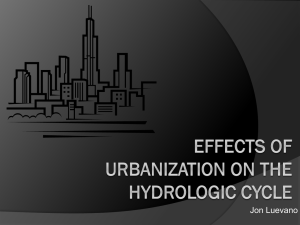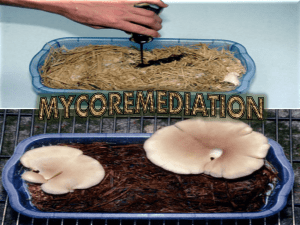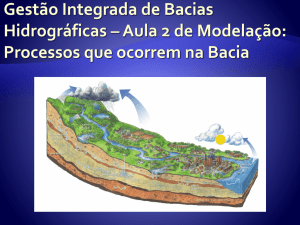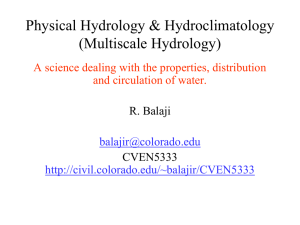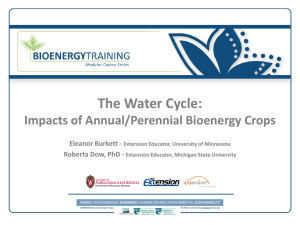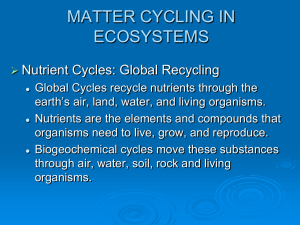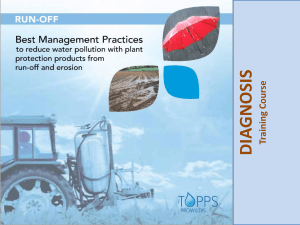7_EU_workship_BMPs_runoff_vl
advertisement
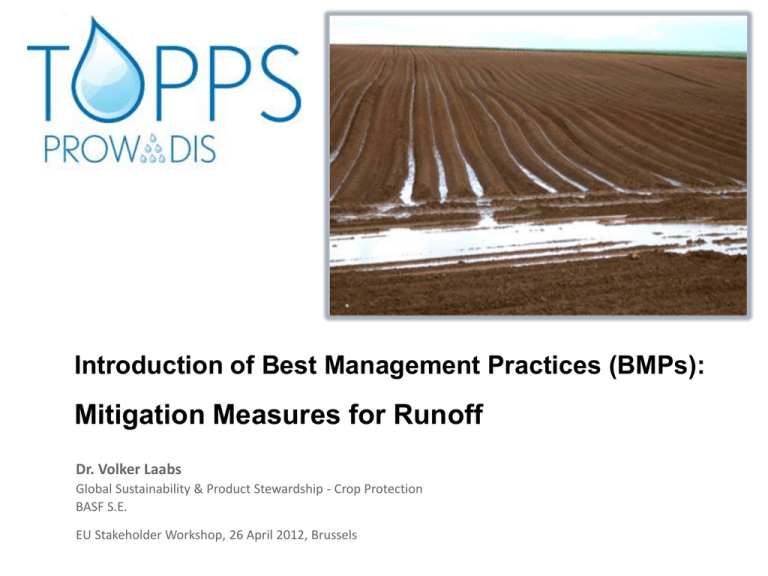
Introduction of Best Management Practices (BMPs): Mitigation Measures for Runoff Dr. Volker Laabs Global Sustainability & Product Stewardship - Crop Protection BASF S.E. EU Stakeholder Workshop, 26 April 2012, Brussels Best Management Practice Mitigation measures follow risk diagnosis Runoff risk diagnosis Basic runoff risk Soil management Cropping practices Landscape factors and concentrated flow issues Mitigated runoff risk Selection of suitable measures… …from toolbox of mitigation measures Optimized soil management Adapted cropping practices Use of buffers and/or retention structures Optimized crop protection practices Key Mitigation Challenge for Runoff: Increase infiltration of water Picture: Jeremy Dyson, Syngenta General BMP Structure Harmonized approach “Statement” “Specifications” What to do? How to do it? A clear communication in form of a general recommendation statement, which will form the core of the harmonized EU BMP. A detailed description of requirements, materials, conditions, and parameters to consider in order to realize the recommendation goal (Subject to country-specific modifications in national BMP toolboxes) Example BMP Runoff mitigation Statement: Manage tramlines to avoid concentrated runoff. Specifications: Whenever possible, tramlines should run across the slope. If possible, shift tramlines in field from year to year Minimize soil compaction by low-pressure tires Tramlines where runoff occurs should be - disked after passing of the tractor OR - vegetated OR - equipped with bunds. A deep soil compaction under tramlines should be broken up mechanically. Runoff Mitigation Measures Category: Soil Management Reduce tillage intensity Do contour tilling/disking Adopt lowest possible tillage intensity Improving aggregation and pore continuity Reducing slaking/micro-erosion due to mulch Soil cultivation follows contour lines in fields Enhances infiltration due to across-slope ridges Manage tramlines Position tramlines across slopes Shift tramlines from year to year Disk or vegetate tramlines Break deeper compactions Avoiding concentrated runoff in tramlines Manage surface soil compaction Break soil crusts Maintain residues on surface Maximizing infiltration in topsoil Prepare rough seedbed Manage subsoil compaction Maintain clods on soil surface by adapted tillage Improving infiltration on rough surface Avoid working too moist soils Break compaction by mechanical means or improve with deep-rooting intercrops Optimizing deep infiltration of water to subsoil Establish in-field bunds Build bunds in vulnerable areas Avoiding concentrated runoff Runoff Mitigation Measures Category: Cropping practices Use crop rotation Use annual cover crops Design crop rotation to increase soil organic matter and optimize soil structure and cover Improving soil aggregation Maximize cover crop use to avoid bare soil Reducing rainsplash erosion, increasing soil organic matter content, improving aggregation Do strip cropping Position field strips across slopes Alternate row and broadcast crops Breaking up long slopes Use perennial cover crops Use suitable plant species to vegetate rows in plantations Protecting soil from rainsplash erosion Improving aggregation of soil and surface roughness Runoff Mitigation Measures Category: Vegetative buffers Use in-field buffers Manage field access areas Position buffers to break up long/steep slopes Stopping and infiltrating water at source Vegetate field access areas Stopping formation of linear runoff towards roads Establish talweg buffers Position buffer in areas of concentrated runoff formation Avoiding runoff in talweg positions Use riparian buffers Position buffers alongside water bodies Stopping runoff before entering ditches/streams/lakes Use edge-of-field buffers Position buffer at downslope field edge Stopping runoff from exiting field Establish hedges Position at downslope edge of field Stopping runoff from exiting field; providing wind shield and biodiversity benefits Establish/maintain woodlands Position at downslope/riparian landscape position Stopping runoff in landscape; providing wind shield and biodiversity benefits Runoff Mitigation Measures Category: Retention structures Use edge-of-field bunds Construct at downslope position where water tends to exit the field Stopping runoff from exiting the field Establish vegetated ditches Position at locations where runoff is unavoidable and occurs regularly Capturing, retaining, and slowly infiltrating runoff in the landscape Establish retention ponds/artificial wetlands Position at locations where runoff is unavoidable and occurs regularly Capturing, retaining and slowly infiltrating runoff in the landscape; additional biodiversity benefits Runoff Mitigation Measures Category: Adapted use of pesticides Adapt application timing Adapt product and rate selection Apply pesticides only when no significant rainfall is forecast (e.g. for ≥2 days) Reducing pesticide concentrations in potential runoff Chose products according to crop protection requirements If water contamination does not improve in spite of other mitigation measures (point, diffuse) … Optimize product choice with regard to - seasonal timing - use rate - substance properties If possible, minimize treated area via band or sensor-based spraying Reducing pollution of known water contaminants Optimize seasonal timing Apply pesticides outside of main groundwater recharge / drainflow season Reducing pesticide concentations in runoff and drainflow Runoff Mitigation Measures Summary: Toolbox for flexible mitigation Mitigation measure toolbox: Soil management • Reduce tillage intensity • Manage tramlines • Prepare rough seedbed • Establish in-field bunds • Manage surface soil compaction • Manage subsoil compaction • Do contour tilling/disking Cropping practices • Use Crop rotation • Do strip cropping • Use annual cover crops • Use perennial cover crops Vegetative buffers • Use in-field buffers • Establish talweg buffers • Use riparian buffers • Use edge-of-field buffers • Manage field access areas • Establish hedges • Establish/maintain woodlands Retention structures • Use edge-of-field bunds • Establish Retention ponds/artificial • Establish vegetated ditches wetlands Adapted use of pesticides • Adapt application timing • Adapt product and rate selection • Optimize seasonal timing Optimized irrigation • Adapt irrigation technique • Optimize irrigation timing and rate Runoff Mitigation Last step: Catchment risk management plan Example: Risk management plan for Fontaine du Theil, FR (Arvalis) Most difficult part: Making implementation of measures happen
